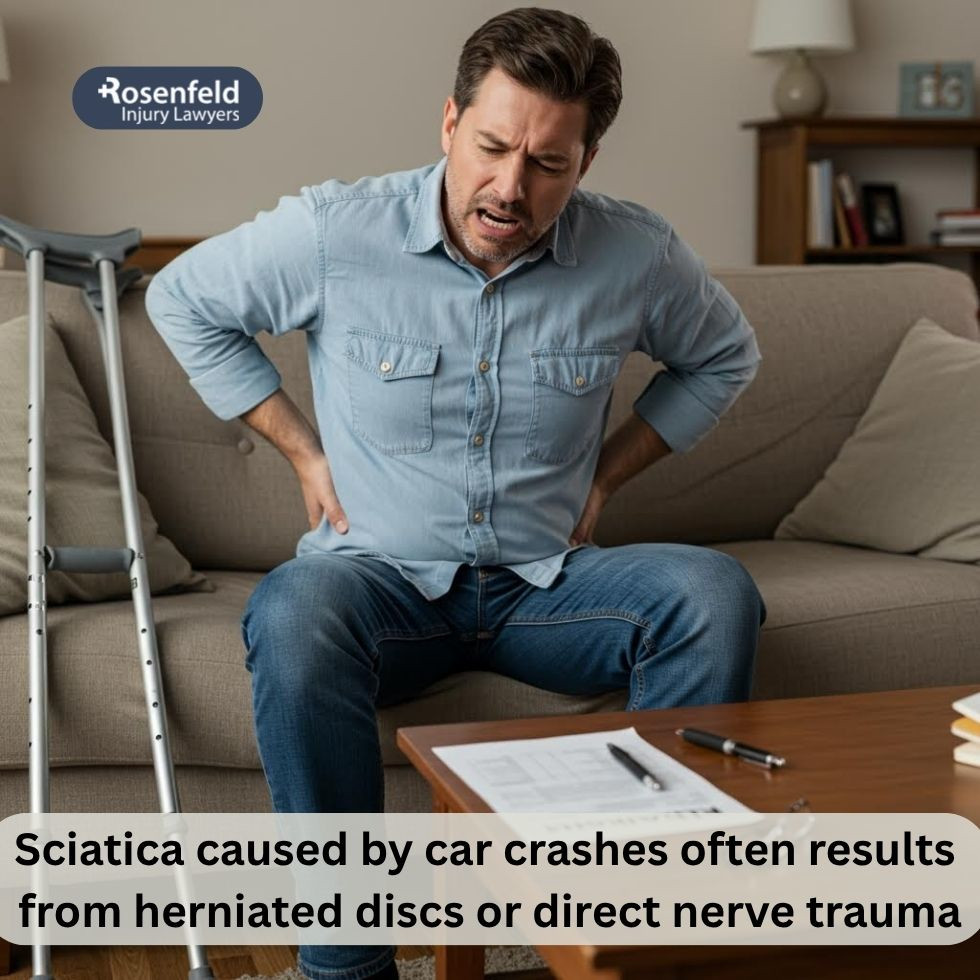- 24/7 Free Consultation: (888) 424-5757 Tap Here To Call Us
Sciatica After a Car Accident
Experiencing sciatica after a car accident can be both physically debilitating and legally complex.
Sciatica is pain that radiates along the path of the sciatic nerve, extending from the lower back through the hips and down each leg. This condition typically arises when the sciatic nerve is compressed or irritated, which can happen from injuries sustained in automobile collisions.
In fact, studies have shown that individuals involved in motor vehicle accidents have a 2.7 times higher risk of developing future lower back pain, with 63% of ongoing cases attributable to prior injuries from such incidents.
Can a Car Accident Cause Sciatica?
A car accident can trigger changes in the lower spine that result in sciatica, often without immediate symptoms. The force of impact may cause spinal compression or misalignment, placing pressure on the longest and thickest nerve in the body, the sciatic nerve.
Common sources of sciatica after a crash include a ruptured disc pressing on nearby nerves, bone fragments from a fracture, or inflammation near the nerve root. In many cases, symptoms are delayed due to adrenaline masking the pain.
Even with a pre-existing spinal condition, Illinois law allows injured individuals to seek compensation if the auto accident worsens their condition. Because sciatica can be disabling, early diagnosis and appropriate care are essential for recovery and legal support.

Common Causes of Sciatica and Herniated Discs in Car Accidents
Sciatica after a car accident usually develops from specific types of back injuries that affect the lower spine. One common trigger is a herniated disc, where the inner material of a disc bulges out and irritates nearby nerves. A high-impact crash can also cause spinal fractures that narrow the lower spinal canal, leading to spinal stenosis and pressure on the sciatic nerve.
In some cases, inflammation or soft tissue damage around the spine adds to the compression, worsening symptoms over time. Individuals with a pre-existing condition, such as degenerative disc disease, are especially vulnerable to sciatic pain after a collision.
If trauma from the accident accelerates this deterioration, it can lead to serious nerve damage and long-term discomfort.
Prompt imaging and medical evaluation are important to identify the underlying source of the pain. It also makes it easy to connect the sciatica to the accident when filing a claim.
Signs You May Have Developed Sciatica From an Accident
Many people notice symptoms of sciatica within hours or days after a car accident, especially if there’s been trauma to the lower spine. One of the most common indicators is sciatica pain that begins in the lower back and travels down one leg, often following the path of the sciatic nerve. This discomfort can feel sharp, burning, or electric and may worsen with movement.
Other symptoms include a weakness in the buttocks, legs, or feet. Some individuals experience difficulty sitting or standing for long periods, as these positions put added pressure on the nerve. If the body is trying to compensate for the injury, walking or maintaining posture may become difficult.
These signs suggest the injury is affecting the lower spine and causing sciatica, making it important to seek medical evaluation right away to confirm the diagnosis and begin appropriate care.

Seeking Medical Treatment for Car Accident Sciatica
If you’re feeling intense discomfort in your lower back after a car accident, it’s important to recognize the signs of sciatica as early as possible. These symptoms may indicate damage to the sciatic nerve, and without immediate medical attention, the condition can quickly worsen.
Common Symptoms of Sciatica After a Car Accident
- Sharp or radiating pain from the lower back down the leg;
- Tingling sensation, numbness, or weakness in the foot or leg;
- Difficulty walking, standing, or sitting for extended periods;
- Worsening discomfort with movement or posture changes.
To avoid long-term complications, it’s essential to get a proper diagnosis from a doctor who understands the severity of nerve-related injuries from auto accidents.
Common Diagnostic Tools and Treatment Options
- CT scans, X-rays, and MRIs to locate disc injuries or inflammation;
- EMGs to measure electrical impulses and identify nerve disruption;
- Physical therapy to restore function and reduce pain;
- Medication to manage inflammation and nerve irritation;
- Surgical intervention in cases of a herniated or ruptured disc.
Once diagnosed, appropriate treatment depends on the severity of nerve compression and how much function has been lost. Options include:
- Physical therapy to improve strength, flexibility, and reduce pressure on the nerve.
- Pain medication to manage discomfort and inflammation.
- Surgery may be necessary if the nerve compression is advanced or mobility in the foot is affected.
If untreated, chronic sciatica can make a pre-existing condition worse, leading to lasting pain, reduced mobility, and nerve damage. Serious back injuries can also limit one’s ability to work.
Understanding Which Insurance Companies Pay for Medical Bills
After a car accident that results in back injuries, figuring out who covers your medical bills depends on the circumstances of the crash. If the at-fault driver is identified, their insurance policy may be responsible for expenses related to nerve damage, x-rays, visits to the doctor, and other injury-related costs.
You may also be eligible to file a claim through your own auto policy, especially if you carry MedPay, or use your health insurance to offset immediate expenses.
If the crash happened while you were on the job, a workers’ compensation claim might also help cover costs such as lost wages, replacement services, and pain caused by sciatica or other injuries tied to the collision.
Proving Liability in Your Claim
Insurance companies often try to downplay car accident claims by blaming back injuries or sciatica on pre-existing conditions. They may argue that your pain doesn’t qualify for compensation.
A skilled attorney can counter their arguments with medical records, imaging, and crash reports that link the injury to the accident. With expert testimony and clear documentation, they can show how the at-fault driver caused or worsened your condition, helping you recover full compensation.
How Much Compensation Can You Receive for Sciatica?
If a car accident causes sciatica, several key factors affect your compensation. The extent of your injury, required treatment, and impact on daily life all matter.
You may be able to recover compensation for:
- Medical expenses (past and future care)
- Lost wages due to time off work
- Replacement services (e.g., help with daily tasks)
- Projected lost income if the injury limits future earning ability
- Long-term care needs, such as physical therapy or surgery for herniated discs or nerve damage
In many cases, individuals experience shooting pain or numbness in the leg region that limits mobility and causes long-term discomfort, contributing to emotional suffering and reduced quality of life.
Typical car accident settlement amounts depend on how clearly your sciatica pain is linked to the crash and how seriously it affects your life. Insurance companies often dispute claims, so seeking medical attention early and gathering detailed records strengthens your case. If another driver caused the injury, you may be able to seek compensation.
Nerve Damage From Car Accidents: Long-Term Implications
Sciatica can lead to chronic pain, mobility issues, and permanent nerve damage. If left untreated, complications may include:
- Loss of muscle function in the affected leg.
- Reduced ability to work in physically demanding jobs.
- Ongoing medical care that adds financial strain.

Why You Need an Experienced Attorney for a Sciatica Claim
Hiring a knowledgeable Chicago car accident attorney gives you an edge when dealing with a sciatica claim. They know how to build a strong case and deal with insurers who try to limit settlements. An attorney can:
- Communicate with the insurance company on your behalf.
- Collect records and documentation from your doctor.
- Prove the link between the car accident and sciatica.
- Include lost wages from back injuries or nerve damage in the claim.
If the at-fault driver’s insurer refuses to pay fairly, your attorney can file a lawsuit and present expert-backed evidence in court. The strength of your representation often affects car insurance claims.
Having a seasoned lawyer on your side signals you’re prepared to fight for what you’re owed.
Get a Free Consultation With a Chicago Car Accident Lawyer

If you’re dealing with sciatica after a car accident, speaking with a Chicago personal injury attorney can help protect your rights. A free consultation gives you the chance to understand your options and learn how to pursue a fair settlement.
If your lower back injury caused severe pain due to a car accident, you deserve compensation. Let an experienced attorney handle the insurance company while you focus on your recovery.
Call our office at (888) 424-5757 or fill out our contact form.
All content undergoes thorough legal review by experienced attorneys, including Jonathan Rosenfeld. With 25 years of experience in personal injury law and over 100 years of combined legal expertise within our team, we ensure that every article is legally accurate, compliant, and reflects current legal standards.







